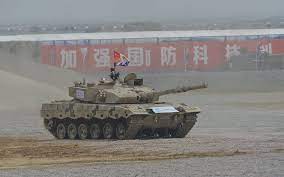
A recent television broadcast in Pakistan has shed light on the advanced production process of the Chinese VT-4 tanks, also known as VT-4 MBT or MBT-3000, at the renowned Heavy Industry Taxila (HIT) manufacturing plant. This facility has been specifically engineered for the production of the VT-4, leading to a significant increase in the production of power units for Al-Khalid/Al-Khalid-1 and T80UD tanks, achieving a remarkable 70% localization.
The broadcast also revealed that 95% of the electrical equipment and control systems used in these armored vehicles are now produced locally, demonstrating a significant degree of self-sufficiency. Interestingly, the Al-Khalid-1 fire control system, a Pakistani innovation, was confirmed to exist, putting an end to previous speculation.
However, the dream of a fully Pakistani-made tank is yet to be realized. Despite the domestic production of several components, including electronics and vision systems for both day and night operations, steel and composite parts still need to be imported from China.
The HIT is currently assembling Chinese tanks under license. Future plans include localizing the production of the gun, specifically the 155mm M109A5 model.
The VT-4 was first introduced to the Pakistan Army in April 2020, making Pakistan the third country to use this tank variant after Thailand and Nigeria. The army has acquired a total of 100 units. The production and export of these tanks have bolstered China’s standing in the global market.
Pakistan first contemplated acquiring VT-4 tanks in 2014 but did not finalize its decision even after extensive testing and witnessing Thailand’s purchase in 2016. Both the VT-4 and the Ukrainian T-84 “Oplot M” tanks were tested within Pakistani borders.
The VT-4, a product of China North Industries Corporation (Norinco), is a third-generation main battle tank. It is equipped with a 125mm smoothbore gun and an automatic loader that can fire 8 rounds per minute. The tank can launch various types of rounds and missiles, with a maximum firing range of 5 kilometers.
The VT-4 is powered by a 1500-horsepower diesel engine and uses a Chinese-made CH10000B hydraulic mechanical automatic transmission. The tank’s layout includes a driver’s seat at the front, a combat compartment in the middle, and an engine at the rear. It features a fully welded turret and composite armor, with the option to add reactive armor plating.
The tank can reach speeds of up to 71 kph and maintain a cruising speed of 42 kph. It has a range of 500 kilometers and can cross water barriers up to 4-5 meters deep and pits up to 2.7 meters wide.
In terms of technology, the VT-4 boasts advanced combat reconnaissance capabilities, including a thermal imager and a panoramic observation system. It also has provisions for installing remote control weapon stations and an integrated fire control system. For enhanced protection, it uses active protection systems, laser alarms, smoke bomb linkages, and an interface for millimeter-wave radar.
The design of the VT-4 incorporates modern technology such as air conditioning, marking a departure from China’s previous simplistic style. This brings it on par with Western tanks. The Pakistani version of the tank is equipped with homegrown FY-4 reactive armor for enhanced defense.
Pakistan’s relationship with China has been strengthened through shared tank technology, and potential collaborations with countries like Ukraine highlight the reach of their alliance.
In April 2020, Pakistan arranged to purchase China’s advanced VT-4 tank with funding from the Gulf region. The deal involved a large order of 300 tanks, with a confirmed order for 176 tanks at $860 million. The deal is contingent on their satisfaction with the first shipment.
By September 2020, Pakistan showcased its new Chinese VT4 tanks. The 52-ton VT4, also known as the MBT3000, was ordered in 2019 and began delivery in 2020. However, plans to purchase more VT4s are currently constrained by financial issues as each tank costs $3 million.




